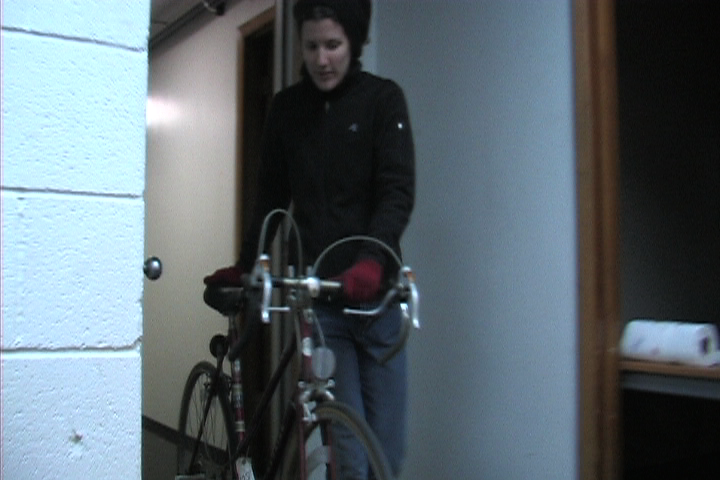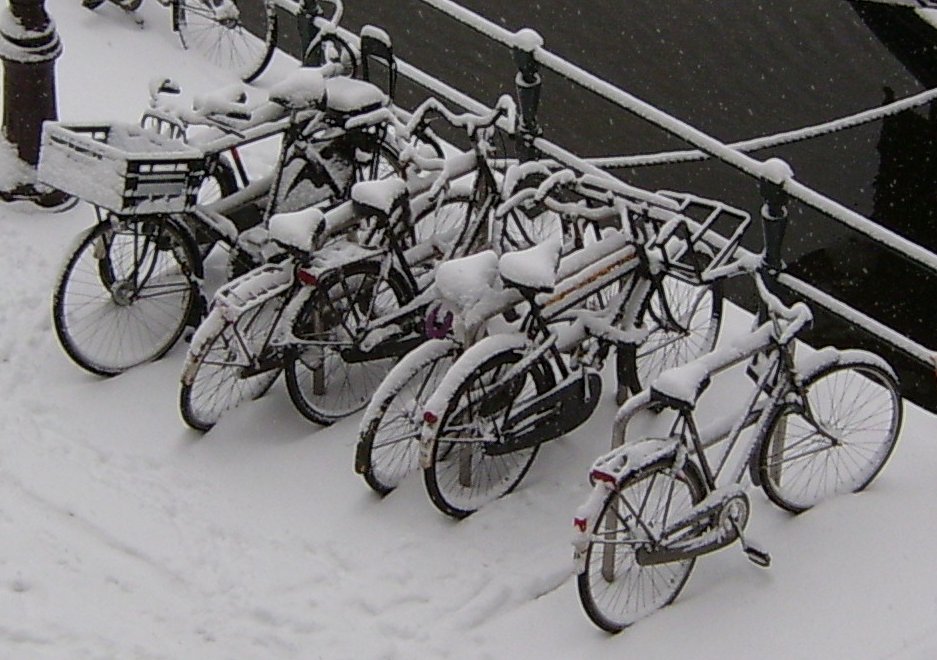For many of us who take environmental protection into our own hands daily, a bicycle is an indispensible part of the dream. Throw off those winter blues… bicycling can make your winter green!
Bicycles are an efficient way to transport yourself daily for a number of reasons. To me, the most important benefit to using a bicycle is that it improves my health and fitness. Probably the next most important to me is a bike’s economy. You pay for occasional maintenance throughout the year, but on the whole, it is far cheaper than using a car, or even travelling by public transportation!
On the environmental front: unlike motor vehicles, bicycles produce no greenhouse gases from their use. Their parts can often be manufactured from recycled materials. Overall, while not perfect, bikes make for a significantly smaller footprint than any other existing mode of efficient, long-travel transportation out there.
The distance from my home to my work is 1.8 miles. (Another good way to think green: move close to your essentials!) Walking, that might take me 40 minutes! But on my bike, I am there in 9-12 minutes. As the nights get longer and the air gets crisper, however, I am reminded that unless I take certain measures, I will soon be prevented from using my bike to get to work by the “elements.” Common enemies to the bicycle include: snow, slush, ice, gravel, and salt.
 But if you’re like me, you strive to think green in all seasons… not just the warm and sunny ones. Surely, winter is the least popular time to ride bikes–it’s cold and difficult, and just plain inconvenient! However, who doesn’t need to keep fit in the winter months? And with a few quick steps and some basic knowledge, you can equip yourself and your bike with the necessities to keep it sturdy and rideable throughout the winter months.
But if you’re like me, you strive to think green in all seasons… not just the warm and sunny ones. Surely, winter is the least popular time to ride bikes–it’s cold and difficult, and just plain inconvenient! However, who doesn’t need to keep fit in the winter months? And with a few quick steps and some basic knowledge, you can equip yourself and your bike with the necessities to keep it sturdy and rideable throughout the winter months.
1. Studded Tires
Combats: ice, snow, slippery surfaces
 One of the most important steps you may want to consider when winterizing your bike is making it capable of sticking to the ground when you are riding or turning corners. Just like getting studded tires for cars, you may want to invest in studded tires for your road bike! Typically road bike tires have very little traction and are fairly smooth. Winter tires will have many more substantial nubs, usually with little metal studs in each (Phattire.com and Penn Cycle give you an idea for these essential winter accessories.) Before you order or buy them, make sure they will match your tire size by checking the measurements on the rim of your tire (usually 27″, 26″ or 700).
One of the most important steps you may want to consider when winterizing your bike is making it capable of sticking to the ground when you are riding or turning corners. Just like getting studded tires for cars, you may want to invest in studded tires for your road bike! Typically road bike tires have very little traction and are fairly smooth. Winter tires will have many more substantial nubs, usually with little metal studs in each (Phattire.com and Penn Cycle give you an idea for these essential winter accessories.) Before you order or buy them, make sure they will match your tire size by checking the measurements on the rim of your tire (usually 27″, 26″ or 700).
In general, mountain bikes–with their thick, wider, nubby tires–will grip any surface better when it is rough. Thus, even if you dislike riding mountain bikes on city streets, you may want to consider getting a mountain bike–with studded tires–for the really messy days this winter.
2. Regular Cleaning
Combats: corrosion and griminess due to salt, dirt
It is extremely important that you clean your bike regularly during the winter. Set aside 30 minutes to an hour a week to thoroughly degrease, scrub, and re-grease your chain (and you may want to consider cleaning your hubs and bottom bracket too). You’ll probably be surprised at how much faster black gunk builds up in the wetter winter months!
Simple Green is the standby for any bike mechanic for degreasing. You’ll want to use chain lube only for re-greasing your chain, while thicker, turquoise-blue poly lube will work for repacking your bearings in the hub and bottom bracket.
Some people may think the biggest threat to the “well-being” of their bicycle is snow, ice, or freezing in the winter months. Actually, the culprit that can cause the most serious problems is: salt! Make sure you do not skip this step when keeping your bike “winterized” for the cold season.
3. Proper Gear
Combats: your discomfort!
Staying warm when speeding past cars in below freezing temperatures can be a challenge indeed. While it is necessary to maintain one’s warmth while travelling, one must be careful not to create conditions where you will overheat due to exertion, sweat, then then chill the water on your skin! Usually tight fitting “Thinsulated” clothing items are needed. The most important, often overlooked, item is the winter face mask–crucial from keeping your cheeks from chapping! Also important are appropriate gloves that protect your hands while allowing you to grip your bike, hats, and ear coverings.
I hope you find this list useful as you ride into the great white beyond. Please consider carefully whether biking is appropriate for your this winter. As any biker’s physical safety is more vulnerable when on the road with cars, consider that reduced visibility and slippery road conditions in the winter make for a dangerous situation–you might be winterized, but the car behind you may not be! Being safe is always more important than living the green dream–at least for now. See you in the streets!
photo credit: Bontenbal under a GNU Free Documentation License (on Wikimedia Commons)


Electric Bike Guy
Don’t forget high visibility LED lights that you can attach to your bike (or person). Visibility is even lessened in the winter time and coupled with potential traction problems of both yourself and the cars around you, making sure those cars can see you from far away is essential.
http://www.ElectricBikeGuy.com
Eugene
I am looking for some idea and stumble upon your posting 🙂 decide to wish you Thanks. Eugene
Bobby B.
I do not if they are green approved, but White Lightning makes some excellent lubricants and cleaners for bicycles.
Jason
Don’t forget poggies – warm baggies that fit over part of the handle bars to protect your hands. In some parts of the world they probably aren’t necessary, but I live in Fairbanks, Alaska and they are indispensable.
Richard Masoner
That’s a good overview.
Hey, I don’t mind you using my photo of the studded tire up there, but I do *insist* on attribution.
sam hdc
Interesting as we have just had an amzing amount of snow today.
Ro
Ha, when I’m cold I just bike a little faster until Im warm again..
No fancy face masks or anything for me. Except a pair of good gloves of course.
buellersway
Hey great tips! Another two I have are bike fenders so you won’t have a nice wet stripe up your back from spinning the rear wheel and the application of some wd40 on some bike parts. WD40 deflects moisture which causes rust. You wouldn’t want it on your chain, thats bad but I have an older bike that has to stay in the shed because I don’t have enough room. Cleaning it constantly is impractical but if I do ride it in the snow. I clean it well then coat everything I can with a rag and some WD40 before it goes back in the shed.
MrGoodfacts
Regarding 1. Studded Tires
“Bicycle tires for on-road use have no need of any sort of tread features; in fact, the best road tires are perfectly smooth, with no tread at all!
Unfortunately, most people assume that a smooth tire will be slippery, so this type of tire is difficult to sell to unsophisticated cyclists. Most tire makers cater to this by putting a very fine pattern on their tires, mainly for cosmetic and marketing reasons. If you examine a section of asphalt or concrete, you’ll see that the texture of the road itself is much “knobbier” than the tread features of a good quality road tire. Since the tire is flexible, even a slick tire deforms as it comes into contact with the pavement, acquiring the shape of the pavement texture, only while incontact with the road.
People ask, “But don’t slick tires get slippery on wet roads, or worse yet, wet metal features such as expansion joints, paint stripes, or railroad tracks?” The answer is, yes, they do. So do tires with tread. All tires are slippery in these conditions. Tread features make no improvement in this.” Sheldon Brown